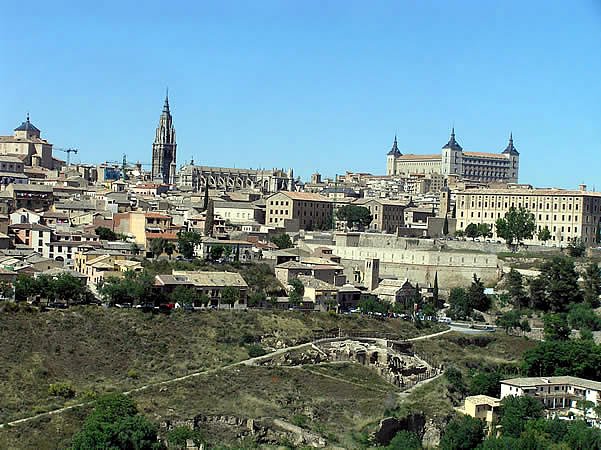This post is also available in:
![]() العربية
العربية ![]() 简体中文
简体中文 ![]() 繁體中文
繁體中文 ![]() Deutsch
Deutsch ![]() Русский
Русский ![]() Türkçe
Türkçe ![]() Français
Français ![]() Italiano
Italiano ![]() Português
Português ![]() Español
Español
Spain (Reino de España/Kingdom of Spain) is a parliamentary monarchy, which lies in the south-westernmost part of Europe. Spain is located on the Iberian Península, of which it occupies approximately 85%. The remaining 15% are occupied by Portugal. Spain also includes the islands of the Balearics in the Mediterranean Sea and the Canaries in the Atlantic Ocean.
The capital city is Madrid, while the other main cities are Barcelona, Valencia, Seville, Malaga, Granada, Cordoba, Bilbao, Salamanca, Zaragoza, Valladolid, Burgos and Toledo. Spain is a member of the European Union.
The administrative division of the country includes 17 autonomous regions, which are: Galicia, Asturias, Cantabria, Castile and Leon, the Basque provinces, La Rioja, Navarre, Aragon, Catalonia, Madrid, Castile La Mancha, Extremadura, Andalusia, Murcia, Valencia, the Balearic and Canary Islands.
Also part of Spain are the Plazas de Soberania en el Norte de Africa: Ceuta, Melilla and some small islands off the Mediterranean coast of Morocco. The country is bordered to the north-east by France and Andorra, to the west by Portugal, to the north, northwest and south-west it is washed by the Atlantic Ocean and to the east and south-east by the Mediterranean Sea.
[divider]
[divider]
THE GEOGRAPHY OF SPAIN
Much of Spain is covered by the Meseta, a vast interior plateau. To the north the Cantabrian mountain range, which includes the Picos de Europa with 2,648 m, forms the northern edge of the Meseta. To the east the margin of the Iberian Meseta is marked by a complex array of chains, which at various points exceed 2,000 m, even reaching 2,313 m in the Sierra del Moncayo.
Finally the southern side of the Meseta is formed by the Sierra Morena mountains with 1,323 m beyond which the Andalusian plain with the Guadalquivir valley is to be found, separating the Meseta from the Betico system, touching greater heights in the Sierra Nevada with peaks beyond 3,000 m. Here is the highest peak of the Iberian Peninsula: Mount Mulhacén with 3,478 m.
Also high altitudes reach the Pyrenees through the Pico de Aneto with 3,404 m, which form a natural border of northeastern Spain with France from the Atlantic Ocean to the Mediterranean Sea for more than 400 km.
[divider]
[divider]
Spain is rich in rivers. There are five major rivers. Four of them the Tagus/Tajo, Duero, Guadiana and Guadalquivir flow into the Atlantic. The Ebro, however, runs south of the Pyrenees, flowing into the Mediterranean Sea. The Duero Basin is with more than 98,375 sq km the largest of the country. The Tagus/Tajo with its course of 1,007 km is the longest river of the Iberian Peninsula.
THE ISLANDS OF SPAIN
The Balearic Archipelago is located in the Mediterranean Sea between the east coast of Spain and Sardinia. It has an area of 4,992 square kilometers and 796,400 inhabitants. The capital city is Palma de Mallorca. This archipelago is formed by the islands of Majorca, Menorca, Ibiza, Formentera and smaller islands.
The archipelago of the Canaries lies a few hundred kilometers off the African coast of Morocco. It has an area of 7,447 square kilometers and 1,630,000 inhabitants. The capital is the city of Santa Cruz de Tenerife. The archipelago consists of seven main islands: Tenerife, Gran Canaria, Lanzarote, Fuerteventura, La Palma, Gomera and Hierro. On the island of Tenerife is the highest mountain of the archipelago and the highest summit of Spain: the volcano of Pico de Teíde with 3,710 m.
The climate of Spain.
Official site of the Spanish government.
English text correction by Dietrich Köster.
[divider]
[divider]
- Area: 505,957 sq km
- Population: 42,744,000
- State Capital: Madrid
- Official Language: Spanish is the official national language on the entire national territory. The following regional languages coexist with Spanish: Catalan in Catalonia, Valencian in the Valencia Region and a particular variety of Catalan – Mallorquín – is spoken on the Balearic Islands, Galician in Galicia and Euskera/Basque in the Basque Country.
- Religion: The majority of the people are Catholics. Other religions practised include Islam, Judaism, Protestantism and Hinduism.
- Currency: Euro (EUR)
- Time Zones: Central European time on the Iberian Peninsula and on the Balearic Islands. One hour less in the Canary Islands. The time zone on the Spanish mainland and the Balearic Islands is UTC+1 in winter and Summer Daylight Saving Time is UTC+2. On the Canary Islands it is UTC or UTC+1 in summer, i.e. always 1 hour less than the time on the mainland and on the Balearic Islands.
[divider]
This post is also available in:
![]() العربية
العربية ![]() 简体中文
简体中文 ![]() 繁體中文
繁體中文 ![]() Deutsch
Deutsch ![]() Русский
Русский ![]() Türkçe
Türkçe ![]() Français
Français ![]() Italiano
Italiano ![]() Português
Português ![]() Español
Español
